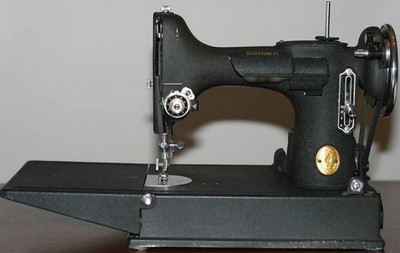Green around the gills
ISMACS News
Issue 52
Carolyn M Ybarra

DOES YOUR white-coloured Singer Featherweight (FW) look a little "green around the gills"? Don't worry: it's not a sign of illness!
That mint-green shade is more likely a reflection of 1950s and '60s industrial-design trends. While most Singer Featherweight 221 and 221K models were manufactured in the shiny japan-black found on many other sewing machines, there were at least two other colours and a matte-black finish available.
The most-frequently found alternate colour is usually referred to as white. The 221K, made in the Kilbowie plant in the 1950s and 60s, came in white as well as black. Many of our Canadian friends own these white-coloured machines which have shorter bed extensions than the black 221s.
Some FW owners have sworn that theirs is not white at all, but rather a mint green. Your own GF has recently done some intensive sleuthing and discovered that Singer marketed a FW machine which was described in sales literature as "pale turquoise".
Either the mint-green machines are those that were referred to as "pale turquoise" or - less likely - there were actually pale-turquoise (blue) machines marketed. We are still not sure if there were also pure-white models that did not have any greenish tinge.
One US collector who has over 200 FW machines swears that he has a non-minty, non-pale, purely-green machine!
All known 221J models are light tan. The "J" indicates Canadian manufacture. It is unclear whether or not some tan machines were also manufactured in Scotland. The shiny tan surface is a creamy edible-looking shade halfway between a white chocolate and a pale caramel. The face plate differs from the striped or scrollwork metal plate found on the japan-black machines. It is a continuation of the same creamy tan, shaped with a long tapering drip melting down the middle, which reinforces the edible aesthetic of the colour.
I know of a few matte-black machines in quilter's or collector's hands which were produced in the United States. This surface has been fondly referred to by FW aficionados as "godzilla stucco" - "godzilla" for its ugliness (first coined by an online FWfanatic to describe the homelier grapeless version of the Singer 128) - and "stucco" for its bumpy texture.
There is a dubious but amusing theory that matte-black machines were only sold to the military, and that their surface was a means of ensuring that they would not reflect light in the heat of battle and betray troop location to the enemy! One somehow doubts that 11 lb sewing machines were a part of the regular troop kit. The matte-black machines on record were manufactured in 1939-40 when the US was not yet at war.
The matte-black machines have touches of Japan finish on the inside of the handwheel and the light switch. There is no gold trim on the base, rather there are three parallel grooves along the front and back when the gold trim would be. This design difference indicates a different mould or form being used for these than that in use for the standard shiny-black machines. Some matte-black machines have a striated faceplate exactly like that on the post-war Japan-black machines. Others have a black-matte faceplate with three striations.
Some colour mysteries may be based on repainting, as in the "matte-black" machine one collector was offered, which turned out to be a very bad paint job over a japan-finish machine, with the gold leaf showing through the paint!
Research on Singer Sewing Machines
Company advertising literature as well as interviews with retired repair and sales personnel could shed more light on the full spectrum of colour variations to be found on FW machines. And then there are the cases ... Stay tuned!
Notes:
1. This article relies heavily on the survey of machines owned by on-line members of FWfanatics, conducted by ISMACS member Krisi Santilla, and on personal communication with Santilla.
2. Free-arm model 222K Featherweights appear to have only been produced in japan black.
3. The initial following the model number represents the plant in which the machine was manufactured. "K" refers to the Kilbowie plant in Scotland, "J" to the St Johns plant in Canada and no initial implies US manufacture.
Model numbers should not be confused with serial numbers on the bottom of machines which can be used for obtaining date of manufacture.





